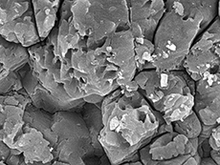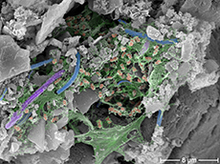Archive detail
Biofilms: hospitable habitats for bacteria in karst aquifers
January 22, 2014 |
Microscopic life in rivers and lakes has been extensively studied: the biochemical dynamics of surface waters are determined by bacteria, free-floating algae and single- or multi-celled zooplankton. But very little is known as yet about microbial communities in groundwater – even though, according to recent estimates, bacteria account for more than half of the Earth’s total biomass, and around 40 per cent of prokaryotic biomass occurs within the saturated subsurface. While these microorganisms are of no relevance for the health of water users, they influence subsurface geochemical processes, such as karst formation. A Swiss-led international research team is currently investigating biodiversity and the distribution and function of microbial communities in karst aquifers. The research has already produced some surprising findings.
Dormant cells in spring water
In countries such as Switzerland, Austria, Italy and Germany, over 70 per cent of drinking water is sourced from groundwater, with a considerable proportion coming from karst systems. However, karst springs are regarded as more vulnerable to contamination than groundwater wells in the sandy-gravelly soils of valleys. Although these aquifers produce water of good quality under base flow conditions, surface contaminants can easily enter karst water via fissures and caves during rainfall events, and this can then emerge virtually unchanged at spring outlets.
In collaboration with colleagues from the Vienna University of Technology, Eawag microbiologist Inés Wilhartitz has now shown that karst aquifers are inhabited by so-called autochthonous (i.e. indigenous) microbial communities. The researchers also demonstrated that, while spring water contains planktonic cells, about 90 per cent are in a dormant state – showing minimal or no metabolic activity. This could be attributable to the low nutrient levels found in karst systems. But, as Wilhartitz points out, “That does not mean there is no biological activity in these systems.” The researchers’ experiments indicate that, in karst aquifers, metabolic processes mainly occur in the biofilms which develop on rock surfaces and – well protected – in tiny interstices (Fig. 2). “Here,” says Wilhartitz, “bacterial production and presumably also other metabolic processes are around a million times greater than in the water.” This means that the biogeochemical processes influenced by bacteria in karst aquifers – including self-purification – are almost entirely attributable to activity within the biofilm compartment.
Biodiversity influenced by catchment land use
In order to find out more about the composition of the microbial communities endemic to particular sites, the team has investigated 40 karst aquifers right across the Alps. The more the researchers discover about the significance of biofilms hidden within the subsurface, the more questions arise about their composition. Evidently, the biogeographical patterns identified reflect land use in the catchment, as well as various environmental factors such as the type of rock or water residence time. Because these local aquifer communities respond rapidly to stressors – e.g. contamination by substances entering groundwater from the surface – it is important to gather more information about them.
Over the last two years, thanks to modern methods of genetic analysis (parallel sequencing and total community divergence measures), large volumes of data on karst microbiology have been collected. On this basis, the status quo in the karst aquifers studied has been defined for the first time. As Wilhartitz explains, “This is the only way of ensuring that it is possible to detect future changes in the composition and function of microbial communities – caused by climate change, tourism or agriculture, for example.” Sustainable management of subterranean biodiversity and the functioning of these sensitive ecosystems thus assumes an importance which goes beyond the purely ethical dimension.
Preventive quality control for karst springs
But the results of the ongoing studies will not only help to document future environmental changes. They already offer direct benefits for water suppliers dependent on karst springs: even before the arrival of “young” surface water, sudden changes in bacterial cell counts and certain carbon components of spring water indicate when heavy rainfall or other events within the catchment are likely to lead to a deterioration of water quality. Equipped with this information, water managers can ensure that, if necessary, karst springs are disconnected from the distribution network in good time.
Controlling factors: viral infection and nutrient availability
Bacteria are an important part of the food web in groundwater, as they can be eaten by higher organisms such as flagellates. But is predation the main controlling factor? Inés Wilhartitz and her colleagues have now shown that, rather than being threatened by other organisms, bacteria in karst aquifers tend to be controlled by a combination of limited nutrient availability and viral infection. The bacterial fragments which remain after viral lysis provide a food source for other bacteria. This may be crucial to the survival of endemic autochthonous bacterial communities in karst aquifers, given the lack of surface nutrients in older systems (water residence times of 10–20 years).
The 3-year project “Microbial communities inherent to karstic aquifers – ecological driving forces in the depth”, funded by the Swiss National Science Foundation under the “Ambizione” programme, runs until the end of April 2014. As well as Eawag, the institutions participating include the Vienna University of Technology, the Universities of Ljubljana (Slovenia) and Greifswald (Germany), Joanneum Research (Austria), the Federal Office for the Environment (Switzerland) and other authorities. Further Information
Karst areas
As well as their highly distinctive landforms – e.g. sinkholes or karren fields (pictured here a karren field near the Pragel Pass in Canton Schwyz) – karst areas are characterized in particular by their subsurface hydrology. Here, rather than seeping or flowing through porous rock or gravel, water passes through fissures and caves. These develop over time as a result of chemical weathering of limestone (calcium carbonate) and other sedimentary rocks: rainwater reacts with carbon dioxide to form carbonic acid, which dissolves carbonate rocks. But the balance between lime and carbonic acid is also influenced by the metabolic activity of microorganisms. It is estimated that, worldwide, 20–25 per cent of the population are wholly or partly dependent on karst systems for their water supplies. Typical karst areas in Switzerland include the Jura, the Höllloch cave system in Canton Schwyz and the Toggenburg region.
The Siebenhengste-Hohgant cave system in the Bernese Oberland. In karst areas, water resides underground for up to 20 years.
(Photo: Robbie Shone)





